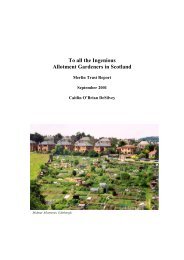Scot plot guide Q3:layout 7 - Scottish Allotments and Gardens Society
Scot plot guide Q3:layout 7 - Scottish Allotments and Gardens Society
Scot plot guide Q3:layout 7 - Scottish Allotments and Gardens Society
Create successful ePaper yourself
Turn your PDF publications into a flip-book with our unique Google optimized e-Paper software.
<strong>Scot</strong>tish <strong>Allotments</strong>& <strong>Gardens</strong> <strong>Society</strong>The<strong>Allotments</strong>Regeneration Initiative<strong>Allotments</strong>A <strong>Scot</strong>tish Plotholder’sGuidewith information on howto get a new site
This <strong>guide</strong> waswritten bymembers of the<strong>Scot</strong>tish<strong>Allotments</strong> <strong>and</strong><strong>Gardens</strong> <strong>Society</strong>ExecutiveCommittee forthe <strong>Allotments</strong>RegenerationInitiative<strong>Allotments</strong> –A <strong>Scot</strong>tish Plotholder’s GuideContentsThis <strong>guide</strong> covers the basic culture of allotment gardening <strong>and</strong>allotment law. A range of organisations that can give you further help,advice <strong>and</strong> support is mentioned throughout <strong>and</strong> contact details arelisted in Resources.1 Introduction to allotments.........................................12 Provision ......................................................................33 Tenancy agreements <strong>and</strong> rules ..................................64 Rents <strong>and</strong> funding ......................................................75 Health <strong>and</strong> safety on allotments...............................86 What you can <strong>and</strong> cannot do on an allotment........97 Beekeeping <strong>and</strong> other livestock ..............................118 Protection <strong>and</strong> legislation........................................129 How do I get started? ..............................................1410 Resources...................................................................16GlossaryAllotment garden: More commonly ‘<strong>plot</strong>’. To beused wholly or mainly in the cultivation of fruit<strong>and</strong> vegetables for use by the <strong>plot</strong>holder <strong>and</strong>family. See legislation for legal definition.Allotment provider: The organisation that rentsout the allotment <strong>plot</strong> to the <strong>plot</strong>holder. Oftenalso known as the ‘L<strong>and</strong>lord’.Allotment site: Collection of allotment <strong>plot</strong>s.Devolved management: Arrangement by whichthe allotment gardeners manage the allotmentsite themselves in formal agreement with theallotment provider. The allotment gardenersusually form an Allotment Association in orderto function in this role.Lease: Legal document signed by an allotmentassociation operating under devolvedmanagement.Local authority: One of <strong>Scot</strong>l<strong>and</strong>’s 32 directlyelected bodies covering the whole of <strong>Scot</strong>l<strong>and</strong>with the responsibility to provide allotments.Missive of Let: Tenancy agreement, rentalagreementOrganic cultivation: A gardening methodwithout the use of chemical fertilisers orpesticides, focusing on increasing the naturalhealth of the soil.Plotholder: The person renting the <strong>plot</strong> from theAllotment Provider.Rural Affairs <strong>and</strong> the Environment: <strong>Scot</strong>tishGovernment Department with responsibility forallotments.
1 Introduction to allotmentsMaggie RodenAllotment gardening provides the opportunity for ayear-round healthy lifestyle. <strong>Allotments</strong> help toaddress issues that directly affect people such as,food provenance <strong>and</strong> food security, sustainability,healthy living <strong>and</strong> eating, whilst at the same timeallotments contribute positively to the environment<strong>and</strong> biodiversity by providing high qualityagricultural growing spaces, which also provide ahabit for native flora <strong>and</strong> fauna.This publication is for existing allotment <strong>plot</strong>holders<strong>and</strong> anyone considering renting an allotment.Individuals <strong>and</strong> groups looking to create newallotment sites may also find this publicationuseful. The primary aim of this document is to givea <strong>guide</strong> to their rights <strong>and</strong> responsibilities <strong>and</strong> to'allotment culture'. It does not aim to give gardeningadvice - there are many excellent books <strong>and</strong> otherresources that do this. There are a range oforganisations that can give you additional guidance<strong>and</strong> support. Contact details are listed in Resources.What is an allotment?Historically in <strong>Scot</strong>l<strong>and</strong> there was a distinctionbetween ‘allotment’ <strong>and</strong> ‘allotment garden’. Anallotment was quite a large piece of l<strong>and</strong> (at leastan acre) <strong>and</strong> could be used to keep livestock. Atthe time of writing, there do not appear to be anyallotments (in this sense) in <strong>Scot</strong>l<strong>and</strong>. An allotmentgarden (<strong>plot</strong>) is defined in law as being not morethan 40 poles (that is ¼ acre or about 1000sqm).Today 200/250sqm is often regarded as a typical<strong>plot</strong> size, but in fact the size (<strong>and</strong> shape) willdepend on what can be fitted into the site.Increasingly some sites are offering smaller ‘halfsize’or even ‘starter’ <strong>plot</strong>s with raised beds forpeople new to allotment gardening or those whowish to down-size. Modern allotment sites oftenhave <strong>plot</strong>s rented by community groups <strong>and</strong> mayalso have common areas of grass <strong>and</strong> othercultivation for the amenity of all <strong>plot</strong>holders on thesite.<strong>Allotments</strong> - A <strong>Scot</strong>tish Plotholder’s Guide 1
Who owns <strong>and</strong> manages allotments?There are three main types of organisationsinvolved in the day to day leasing <strong>and</strong> managing ofallotments:• Local authority, i.e. a city or district council• Other l<strong>and</strong>owners• Allotment associations or societies made up ofthe <strong>plot</strong>holders.The audit Finding <strong>Scot</strong>l<strong>and</strong>’s <strong>Allotments</strong> 2007 1found that 69% of sites in <strong>Scot</strong>l<strong>and</strong> are owned bythe local authority. Other providers include auniversity, housing associations, a convent, varioustrusts <strong>and</strong> other estate or private l<strong>and</strong>owners. In afew cases the allotment association actually ownsits own site.Sometimes an allotment site is managed directlyby the provider. In this case the primary contactwill be between the individual <strong>plot</strong>holder <strong>and</strong> theprovider. However, quite often day to daymanagement of a site is devolved to an allotmentassociation for the site. In this case <strong>plot</strong>holdersmay have to take responsibility for letting the<strong>plot</strong>s, for maintaining a waiting list if this isnecessary <strong>and</strong> for the repair <strong>and</strong> maintenance ofcommunal facilities. Even if the allotment providerperforms most management tasks, an allotmentassociation can be useful as a channel forconsultation <strong>and</strong> communication between theprovider <strong>and</strong> the <strong>plot</strong>holders. In some localauthority areas site associations come together ina forum or federation to provide an additionalmeans for <strong>plot</strong>holders to raise issues of commonconcern.If the local authority has a published allotmentstrategy document then this will outline themanagement policies the local authority has for itssites.Benefits of <strong>Allotments</strong>The produce you grow contributes to a healthybalanced diet for you, your family <strong>and</strong> friends. Youcan have fresh vegetables all the year round <strong>and</strong>fresh fruit for up to nine months <strong>and</strong> this mayreduce your food costs.Gardening is moderate exercise, which is shownto decrease the risk of heart disease, diabetes <strong>and</strong>cancer 2 . It contributes to both physical <strong>and</strong> mentalwellbeing for all ages. Older people can benefitfrom the combination of gentle exercise <strong>and</strong> socialinteraction with other <strong>plot</strong>holders. Health benefitsextend beyond individual <strong>plot</strong>holders <strong>and</strong> severalsites are working with community groups topromote physical <strong>and</strong> mental health.At least 50 different local community groups arevariously involved with allotment sites. Sites runcommunity events <strong>and</strong> open days, offereducational visits from schools <strong>and</strong> other groups,have school <strong>plot</strong>s contributing to the curriculum<strong>and</strong> Eco School awards.The <strong>Scot</strong>tish <strong>Allotments</strong> <strong>and</strong> <strong>Gardens</strong> <strong>Society</strong>(SAGS) estimate that an average family growing ¼of their produce will save 4% (0.5 tonnes) of theirtotal emissions each year <strong>and</strong> a one hectareallotment site (40-50 <strong>plot</strong>s) saves 25 tonnes ofCO 2 per annum 3 .Children can benefit from spending time on anallotment, either with their family or as part of theschool curriculum. Learning <strong>and</strong> fun can becombined. At the very least children gain anawareness of the diverse species that live in theearth <strong>and</strong> that food does not start out wrapped inplastic.By gardening people can learn how allotmentscontribute to increasing local nature <strong>and</strong> wildlife,<strong>and</strong> maintaining soil infrastructure - 99% of sitesform part of wider open space <strong>and</strong> greennetworks.Barbara De La Rue1 <strong>Scot</strong>tish <strong>Allotments</strong> <strong>and</strong> <strong>Gardens</strong> <strong>Society</strong> (2007) Finding <strong>Scot</strong>l<strong>and</strong>’s <strong>Allotments</strong> www.sags.org.uk2 Dr William Bird for the Royal <strong>Society</strong> for the Protection of Birds, endorsed by the Faculty of Public Health of the Royal Colleges ofPhysicians of the United Kingdom. (2004) Natural Fit, Can Green Space <strong>and</strong> Biodiversity Increase Levels of Physical Activity?www.rspb.org.uk3 <strong>Scot</strong>tish <strong>Allotments</strong> <strong>and</strong> <strong>Gardens</strong> <strong>Society</strong> (2008) Briefing paper on <strong>Allotments</strong>, Food <strong>and</strong> Climate Change: how growing one’s ownfood can reduce emissions from food production www.sags.org.uk2 <strong>Allotments</strong> - A <strong>Scot</strong>tish Plotholder’s Guide
2 ProvisionHow to get a <strong>plot</strong>Plots are in high dem<strong>and</strong> all over <strong>Scot</strong>l<strong>and</strong>. Thereare currently about 7000 <strong>plot</strong>s in <strong>Scot</strong>l<strong>and</strong>, whichaverages at 1 <strong>plot</strong> for every 700 people, so unlessyou are very lucky you must expect to spend timeon a waiting list.The first step is to contact your local authority. In<strong>Scot</strong>tish law the provision of allotments is theresponsibility of the local authority. The localauthority has a duty to give priority to residents inits area, so it is unlikely that you will be offered anallotment outside your local authority’s area. Yourlocal authority should have a record of allallotments in their area, should know about theavailability of <strong>plot</strong>s <strong>and</strong> be able to give you someidea about the length of the waiting list, <strong>and</strong> howto get on it, if there are no available <strong>plot</strong>s. If thelocal authority is not the provider of the allotmentsite then you may have to contact the actualprovider directly. The local authority may be able togive you contact details.The pattern of allotment provision <strong>and</strong>management varies greatly between localauthorities. Some have a named <strong>and</strong> designatedallotment officer, three have no allotments in theirarea, others divide allotment responsibilitybetween a number of departments <strong>and</strong> yet othersonly have independently owned allotments forwhich they take no serious responsibility. SomeLocal authorities have excellent contact details ontheir own website but it can sometimes be hard toaccess the appropriate person. SAGS maintaindetails of contact information on their website at:www.sags.org.uk.In 2007 SAGS published a document Finding<strong>Scot</strong>l<strong>and</strong>’s <strong>Allotments</strong> which gives details of allallotment sites existing at that date. Thisdocument was lodged in local libraries throughout<strong>Scot</strong>l<strong>and</strong> <strong>and</strong> is also available for download fromthe SAGS website.How to formally request provision forallotments from your councilIf the waiting list is too long (<strong>and</strong> it can be sevenor eight years in some places) or if there are noallotments in your area then in law there is aprocedure to request allotment provision. If six ormore residents write to the chief executive of thelocal authority, representing that there is need forallotments in the area then by law the localauthority must consider the representation. Underthe <strong>Allotments</strong> (<strong>Scot</strong>l<strong>and</strong>) Acts, if a local authoritydetermines there is a dem<strong>and</strong>, it has a statutoryduty to provide a sufficient quantity of <strong>plot</strong>s <strong>and</strong> tolease them to people living in its area. Pastexperience shows that groups that formthemselves into an association <strong>and</strong> enlist the helpof local councillors <strong>and</strong> community councils havethe highest chance of success in enforcing thisduty.Equal opportunities<strong>Allotments</strong> operate within the spirit of equalopportunities <strong>and</strong> are rented out on a first-comefirst-served basis, without preferential treatment.Your age, gender, race, cultural background, sexualorientation, religion or health, are not a barrier toyou renting an allotment. The DisabilityDiscrimination Act (1995) exists to ensure peopleare not discriminated against on the grounds oftheir disability. People with additional needsrelating to their health should let the allotmentprovider know at the time of their application foran allotment <strong>plot</strong>, or when health changes occurrequiring adaptations after they have become a<strong>plot</strong>holder. Some allotment authorities havecreated specially adapted <strong>plot</strong>s for disabled people,either on a communal or individual gardeningbasis. Other local authorities deal with adaptationson a case-by-case basis.<strong>Allotments</strong> - A <strong>Scot</strong>tish Plotholder’s Guide 3
Community PlotsIndividuals rent <strong>plot</strong>s, but in addition on many sites<strong>plot</strong>s are rented by community or educationalgroups. The members of the group gain from theknown benefits of allotment gardening, <strong>and</strong> theallotment site may well benefit from a larger poolof volunteers to undertake communal chores <strong>and</strong>also from the funding opportunities that becomeavailable when it is possible to prove communitybenefit.There are several different patterns of provision. Anumber of descriptive terms have emergedalongside the legal term ‘allotment garden’ inrecent years: 'community garden(s)' <strong>and</strong>‘community allotment(s) <strong>and</strong> ‘community <strong>plot</strong>(s)’.None of these terms are recognised in law <strong>and</strong> theinterchangeable way in which they have beenapplied by some providers has led to a great dealof confusion <strong>and</strong> legal disparity. In some casesthere has been a deliberate stance by localauthorities to name new allotment sites‘community gardens’ instead of ‘allotmentgardens’ in order to avoid creating any legalprotection allotments might attract. Some newallotment sites have found it easier to obtainfunding by naming themselves ‘communityallotments’ or ‘community gardens’ in spite ofactually being allotment gardens. Allotmentgardens are, intrinsically, already a community oflike minded people who come together through ashared love of gardening (or a desire to learn) <strong>and</strong>,as such, the use of other terms can lead to anegative perception of what allotment gardensactually are <strong>and</strong> what returns they can offer interms of economic, social <strong>and</strong> environmentalinvestment. Anecdotal evidence shows that wherenew allotment sites are created the gardenersthemselves want to have a variety of <strong>plot</strong>s ofdifferent shapes <strong>and</strong> sizes for both individual <strong>and</strong>collective usage.One possible method of managing waiting lists isthat there are particular <strong>plot</strong>s identified ascommunity <strong>plot</strong>s <strong>and</strong> (if necessary) a separatewaiting list for these <strong>plot</strong>s. Another is that a groupjoins the general waiting list in the same way as anindividual <strong>and</strong> rents a <strong>plot</strong> when it becomesavailable. The normal regulations will apply tomembers of community groups as much as toindividuals <strong>and</strong> there are no reasons to expect anyadditional problems. However, an associationresponsible for managing a site with community<strong>plot</strong>s should be aware that there might be distinctissues that arise, for example there will need to bean individual who is the group’s contact with theassociation by reason of their position. If thisindividual is replaced within the group this shouldnot affect the group’s right to cultivate the <strong>plot</strong>. Inaddition most sites are fenced with locked gates,so there might be a need to consider how manymembers of a community group should be keyholders.Plot conditionA local authority’s minimum obligation is only toprovide l<strong>and</strong> for allotment gardening for itsresidents. This could just be earth in anuncultivated condition <strong>and</strong> the st<strong>and</strong>ard may varyfrom site to site. Local authorities have the powerto improve the l<strong>and</strong> acquired for allotments byenclosing it, draining it <strong>and</strong> creating approaches orroads. If the local authority has an allotmentstrategy then this will outline the responsibility thelocal authority is prepared to accept for its sites.Contaminated l<strong>and</strong>Rarely, soil on allotment sites is found to becontaminated by heavy metals <strong>and</strong> otherpollutants. Produce grown on contaminated l<strong>and</strong>may be unfit for human consumption.Contaminated soil does not mean l<strong>and</strong> can neverbe used for allotments, various techniques existthat can be used to make soil safe for allotmentgardening. SAGS recommends a survey is carriedout on l<strong>and</strong> outlined for new allotments, to obtaindetails of any contaminants present, along withgathering information indicating soil health such aspH, trace elements, soil type. Existing <strong>plot</strong>holderswith concerns about soil on their site shouldcontact their allotment provider in the firstinstance.Onsite facilitiesApart from ensuring that access to the allotmentsite is safe <strong>and</strong> not a barrier to people withdisabilities, the allotment provider is not requiredto provide any further facilities for <strong>plot</strong>holders. It is,however, considered good practice for allotmentproviders to provide well-maintained facilities fortheir <strong>plot</strong>holders to ensure they obtain the fullbenefits of allotment gardening. These include awater supply, toilet facilities, boundary fences,hedges, paths <strong>and</strong> gates.Provision for cars is often a thorny issue <strong>and</strong>planning authorities have strong feeling about this.Wherever possible <strong>plot</strong>-holders should walk, cycle,or use public transport to access their <strong>plot</strong>s.4 <strong>Allotments</strong> - A <strong>Scot</strong>tish Plotholder’s Guide
How to start anew siteIn an ideal world, once a group of six residents haswritten to the chief executive of their localauthority pointing out a dem<strong>and</strong> for allotments, theprovision of a suitable allotment site will followeasily <strong>and</strong> promptly. However very few of us livein an ideal world <strong>and</strong> it is as well to be aware thatthe process of finding <strong>and</strong> setting up a new sitecan require serious commitment. It will be timeconsuming <strong>and</strong> may require funding from sourcesother than the local authority. SAGS can put you incontact with groups who have followed this route<strong>and</strong> the SAGS website contains a number of casehistories from groups that have started a new site.Start a groupThe first step is to find other interested people <strong>and</strong>form a group. Advertise in as many local media aspossible: local papers, notices in local communitycentres <strong>and</strong> libraries, local websites etc. Theorganisation of the group does not need to be veryformal but at the first meeting there should be aclear decision about its aims, <strong>and</strong> a clear allocationof responsibilities. Try to involve local councillors<strong>and</strong>/or community ‘leaders’ in the group.Identify l<strong>and</strong> <strong>and</strong> think about theleaseLocal authority owned l<strong>and</strong> may be unavailable <strong>and</strong>many groups decide to look for a suitable site froman independent l<strong>and</strong>owner. Remember thatsuitability is about more than just area – youshould consider accessibility, drainage, sun/shade,<strong>and</strong> possibilities of contamination.There are likely to be a number of ‘corporate’ l<strong>and</strong>owners in the area apart from the local authority.Does your local hospital have unused l<strong>and</strong>? Woulda housing association allow some of its greenspace to be used for allotments? Is there a bighouse in the vicinity with a derelict kitchengarden? Is there a local farmer with surplus l<strong>and</strong>?Once you have identified suitable l<strong>and</strong> you willneed to negotiate a suitable lease. This shouldprobably be passed to a solicitor, but you will needto decide on matters such as time scale. Aprovider might want quite a short lease, but realallotment gardening is a long-term activity, <strong>and</strong>many funding bodies will not give grants if a leaseis for less than a minimum time. Twenty to twentyfive years has been found to give reasonablesecurity.Fundraise: involve community groupsSetting up an allotment site will have costs. Youwill need to raise these funds somehow. There area number of suitable funding bodies but in generalit will be easier to access funding if you can showthat there is a benefit to the community. Thephysical <strong>and</strong> mental health benefits of gardeningare now well recognized <strong>and</strong> there may be localvoluntary groups providing health rehabilitation orsocial <strong>and</strong> skills training who would be delighted tooffer their fund raising <strong>and</strong> leadership skills inreturn for the promise of a <strong>plot</strong> for the use of theirmembers. For further information see Fundraising– A <strong>guide</strong> to fundraising for allotment associations,published by ARI (Resources).Make sure you lay down management <strong>guide</strong>lines.With the best will in the world, not everyone willagree about everything. Quite early in the processyou should think about such questions as:• what body is to manage the site• how is eligibility to rent a <strong>plot</strong> determined• what can be grown on a <strong>plot</strong> <strong>and</strong> what sizes ofsheds <strong>and</strong> greenhouses can be erected (<strong>and</strong>where)• what st<strong>and</strong>ard of cultivation is expected <strong>and</strong>what happens if a <strong>plot</strong>holder does not conformto this st<strong>and</strong>ard• what communal responsibilities will be laid on<strong>plot</strong>holders.SAGS can offer advice on drawing up suitablemanagement regulations for <strong>plot</strong>s.Ernie Watt<strong>Allotments</strong> - A <strong>Scot</strong>tish Plotholder’s Guide 5
3 Tenancy agreements <strong>and</strong> rulesThe missive of let (tenancy agreement) is a legallybinding document, setting out the rights <strong>and</strong>responsibilities of the <strong>plot</strong>holder, <strong>and</strong> those of theprovider. You will be required to sign the missivewhen you rent an allotment. The missive can bebetween you <strong>and</strong> the l<strong>and</strong>owner (public or private),or between you <strong>and</strong> your allotment association,who may own or rent the l<strong>and</strong> via a separate leasewith a provider.Your missive can be short, referring to separaterules, or lengthy, with all relevant issues covereddetailing what you can <strong>and</strong> cannot do with your<strong>plot</strong>. You should receive a signed copy for futurereference. The missive should be in plain English.You may receive a starter pack of usefulinformation introducing you to the site association,the regional set up <strong>and</strong> basic advice on how totend your <strong>plot</strong>.Why is a tenancy agreement needed?When renting an allotment you are takingresponsibility for a piece of l<strong>and</strong> which is entrustedto you. The allotment provider needs to ensurethat you will manage the l<strong>and</strong> in an appropriateway during your time as a <strong>plot</strong>holder <strong>and</strong> to ensurethat the l<strong>and</strong> will be in a fit state to rent out againwhen you decide to move on. Everyone renting anallotment <strong>plot</strong> needs to underst<strong>and</strong> theirresponsibilities; the missive of let clarifies this.What to expect to be includedNo two allotment sites are exactly the same somissives vary. There are however, some issuesthat are required by law to be included:• Rent: amount (possibly including water charges;renting sheds or other structures); when it isdue; how it is collected; how it is calculated for aproportion of the year; penalties for rent arrears.• Prevention of <strong>and</strong> penalties for nuisance <strong>and</strong>annoyance.• Prohibition of sub-letting to other people by the<strong>plot</strong>holder.• Observance of terms of lease.• Determination of tenancy <strong>and</strong> notices to quit,compensation for improvements to <strong>plot</strong> onservice of notice to quit.• Prohibition of trade or business.• Erection of sheds, greenhouses <strong>and</strong> otherstructures.Additional items may be mentioned in the missive,referring to such things as rules <strong>and</strong> policies, localcircumstances <strong>and</strong> by-laws.Individual allotment <strong>plot</strong>s are normally let for aperiod of one year, although this can be renewedindefinitely as long as you comply with the termsof the missive. If the let is between yourassociation <strong>and</strong> the l<strong>and</strong>owner the let may be forseveral years for the whole allotment site. Themissive will usually include provision for thetenancy to be terminated by either the <strong>plot</strong>holderor the l<strong>and</strong>lord. If the <strong>plot</strong>holder has not compliedwith the terms of the missive or the rules referredto, the provider may give one month’s notice. SeeSection 8: Protection <strong>and</strong> legislation for full details.Underst<strong>and</strong>ing your responsibilitiesIt is important that you read <strong>and</strong> underst<strong>and</strong> theresponsibilities of the missive. Remember it is acontract between you <strong>and</strong> your provider. You needto follow the missive conditions, not only toprotect your own position but also to ensure thatthe site as a whole is not brought into disrepute.RulesIn addition to the missive of let, many allotmentsites have additional general or specific site rules.Adherence to these rules could well be in themissive; they may even be included in detail in themissive. They are usually to ensure theharmonious day to day operation of the site. Theydo not take the place of the missive but act as asupplement. You should receive a copy of the ruleswith your missive <strong>and</strong> they may be displayed onthe site notice board or in the community hut.What to do if you have a problemWe have to accept that from time to time problemscan arise, but they must not be allowed to get outof h<strong>and</strong>. Do not allow problems to fester, opendiscussion is the way to solve a problem.A dispute procedure may be included in your siterules or even the missive of let. One of the rulesmay be that all <strong>plot</strong>holders act in a manner not tocause offence to other <strong>plot</strong>holders. Normally youwould try to solve the problem by talking to theother party. If this fails you would have recourse tothe site association committee who may set up anarbitration panel. As a final resort you would putthe problem in the h<strong>and</strong>s of your provider whoarranged the missive of let.6 <strong>Allotments</strong> - A <strong>Scot</strong>tish Plotholder’s Guide
4 Rents <strong>and</strong> fundingThe annual rent takes into account the cost ofmanaging the site, local needs <strong>and</strong> any specialcircumstances. There is no statutory process ofappeal about rent charges. If you are unhappy withyour rent charges you should take up your casewith your provider. The law does not stipulate areduction in rent for people on low incomes. Someproviders permit concessionary rents, at theirdiscretion. There are waiting lists for allotments inevery local authority in <strong>Scot</strong>l<strong>and</strong>. Essentially youwill need to decide whether you are prepared topay the rent dem<strong>and</strong>ed for the pleasure of growingyour own food.How much rent are you likely to payThe variance can be very wide depending onservices provided. The most expensive known in<strong>Scot</strong>l<strong>and</strong> at £300pa (2009) is at a private site whichprovides free tea <strong>and</strong> coffee, a community cabin,rubbish collection, <strong>and</strong> piped water to each <strong>plot</strong>.The cheapest is £5 pa (2009) with very littlesupport. Included in the rent could be an annualfee to your local <strong>and</strong> national allotmentorganisations.How rents are calculatedThe way in which rents are calculated depends onthe provider <strong>and</strong> services included. If the LA isprovider they should have a long term allotmentstrategy <strong>and</strong> budget <strong>and</strong> therefore the rents can beforecast. You may get a notice about rent chargesfor the future years.If the site association rent the l<strong>and</strong> for a one offannual rent, or if the association owns the l<strong>and</strong>,they will take into consideration any annual repairs,capital investment, st<strong>and</strong>ing charges/rates/watercharges etc, <strong>and</strong> divide that total amongst the<strong>plot</strong>holders. The size of the <strong>plot</strong> may vary slightlyas the shape of the whole site may not cater forBarbara De La Rueuniform <strong>plot</strong>s. Usually you will pay the same for afull <strong>plot</strong> even though your <strong>plot</strong> may vary slightly insize from others on the site. The rent for a half<strong>plot</strong> <strong>and</strong> starter <strong>plot</strong> is generally some designatedfraction of the full <strong>plot</strong> rent.Incentives <strong>and</strong> concessionsAllotment providers should ensure that <strong>plot</strong>s arefree from hazards when setting up new tenancies.If you are taking on a ‘dirty’ (uncultivated) <strong>plot</strong> yourprovider may make special arrangement to removevery heavy weed infestations. You may be offeredthe first years’ rent at a reduced rate or even freeto encourage you to clear <strong>and</strong> cultivate it. Someproviders offer concessions to those on benefit<strong>and</strong> pensioners.Paying your rentRent is normally paid in advance. If you do not payyour rent in line with the terms of your missiveyou could be breaking the contract, <strong>and</strong> you couldlose your <strong>plot</strong>. If you are unable to pay your rentbecause of financial difficulties you should informyour provider immediately.Water ChargesSome providers may include a water charge aspart of the rent, or charge the site an annual fee.Some sites do not have piped water. Any watercharge should be detailed in your missive.Hosepipes may be banned; the provider may offerwater butts for water collection from shed roofs.How the money is spentThe maintenance costs on allotment sites can below, particularly if the <strong>plot</strong>holders volunteer tocarry out basic maintenance themselves. Some ofthe running costs are public liability insurance, skiphire, administration, site <strong>and</strong> security maintenance.Maggie Roden<strong>Allotments</strong> - A <strong>Scot</strong>tish Plotholder’s Guide 7
5 Health <strong>and</strong> safety on allotmentsAll activities carry an element of risk <strong>and</strong>allotments are no exception. Everyone needs totake health <strong>and</strong> safety seriously, but it is also veryimportant to approach the issues sensibly <strong>and</strong> notbecome paranoid about the possibility of litigation.New <strong>and</strong> existing <strong>plot</strong>holders have a responsibility(duty of care) to anyone on their <strong>plot</strong> regardless ofwhether or not they have been given permissionto be there. You should act responsibly <strong>and</strong> complywith any health <strong>and</strong> safety instructions in themissive of let, <strong>and</strong> any subsequent informationgiven by the provider. Health <strong>and</strong> safety onlybecomes unmanageable when responsibilities areneglected.The providers should ensure that the <strong>plot</strong> is freefrom hazards at the time of leasing to a new<strong>plot</strong>holder. New <strong>plot</strong>holders should be advisedabout any ongoing health <strong>and</strong> safety risks orhazards on the allotment site at the time of takingon their <strong>plot</strong> <strong>and</strong> signing the missive.If you are not sure of your own health <strong>and</strong> safetyresponsibilities as a <strong>plot</strong>holder ask your provider. Itis good practice for providers to welcome enquiresfrom <strong>plot</strong>holders about health <strong>and</strong> safety.How to report hazards <strong>and</strong> concernsPlotholders should report concerns about health<strong>and</strong> safety on their <strong>plot</strong>, or site, to the siteassociation committee or provider as soon as theyoccur. It is good practice to have a reportingsystem for <strong>plot</strong>holders. There should be a list ofcontact details on the notice board, <strong>and</strong> a namedMaggie Rodenindividual within the local authority or providers’organisation. You should let any visitors to your<strong>plot</strong> know about any ongoing health <strong>and</strong> safetyissues that you are aware of.Personal SafetyAllotment gardeners often spend long periods oftime alone on their <strong>plot</strong>, so it’s a good idea to letsomeone know where you are <strong>and</strong> when you willreturn home. Contact your local police forinformation about personal safety <strong>and</strong> crimeprevention.V<strong>and</strong>alismMost of the time allotments are havens of peacein an otherwise busy world, where <strong>plot</strong>holders putin many hours of work. In order to reduce the riskof v<strong>and</strong>alism, it is good practice for the provider toensure that adequate security measures such asfences <strong>and</strong> hedging, are in place, <strong>and</strong> that the<strong>plot</strong>holders or the provider maintains them.Plotholders should always report instances ofv<strong>and</strong>alism to the police <strong>and</strong> obtain an incidentnumber, as well as informing the site committee<strong>and</strong> provider of the incident.Reducing chemical useYou can help the environment by minimising theuse of chemical pesticides, herbicides <strong>and</strong>fertilisers <strong>and</strong> promoting non-polluting materials.Organic gardening, without the use of artificialproducts is an effective way of cutting down onchemicals. There are organisations that can giveadvice <strong>and</strong> help you with the practicalities of doingthis. (See Resources)Disposal of ChemicalsPlotholders who use chemicals have a duty of careto store, use <strong>and</strong> dispose of them safely. Thisincludes weed killers, rat poisons, fungicides <strong>and</strong>soil sterilants etc. They should never be decantedinto another container or brought into the UK fromabroad. They should always be stored well out ofreach of children <strong>and</strong> locked away. Plotholdersshould contact their local authority wastemanagement department for information aboutfacilities for the safe disposal of surplus chemicalpesticides, herbicides <strong>and</strong> fertilisers. They shouldnever be included in household rubbish, burnt,placed in skips, or poured into watercourses or anykind of drainage system.8 <strong>Allotments</strong> - A <strong>Scot</strong>tish Plotholder’s Guide
6 What you can <strong>and</strong> cannot doon your <strong>plot</strong>Maggie RodenGardening within the rulesThe <strong>Allotments</strong> Acts (<strong>Scot</strong>l<strong>and</strong>) state that yourallotment is mainly for growing vegetables <strong>and</strong>fruit for your own <strong>and</strong> your family’s use. This is thebasis on which your <strong>plot</strong> is rented to you. Modernpractice is, often, to have some flowers <strong>and</strong> herbsas well as vegetables <strong>and</strong> fruit for home use <strong>and</strong>to attract pollinators.It is essential that any activities you carry out onyour <strong>plot</strong> are acceptable within the terms <strong>and</strong>conditions of your missive of let. You should notchange the nature of the <strong>plot</strong> in a way that makesit less valuable or could affect the provider’s abilityto rent it out again when you leave. Occasionally,some activities may actually threaten the future ofyour allotment site as they change the legaldesignation of the l<strong>and</strong>-use from that of allotmentl<strong>and</strong>, for example using your <strong>plot</strong> for commercialpurposes.Although restrictions on what you can <strong>and</strong> cannotdo on your <strong>plot</strong> will differ from area to area, someare generic to all allotment sites. It is always bestto check your missive of let <strong>and</strong> check with yoursite association for any rules pertinent to the site.Examples of generic restrictions are given below.Being a good neighbourA desire to garden means that you will have muchin common with your fellow <strong>plot</strong>holders. There arehowever some matters of social politeness toconsider when you take an allotment or if you arean existing <strong>plot</strong>holder when a new <strong>plot</strong>holderarrives. Simple things such as lighting a bonfire(see further below) or playing a radio, may affectyour neighbours’ enjoyment of their <strong>plot</strong>. Setground rules for your visitors <strong>and</strong> children on your<strong>plot</strong>. For other <strong>plot</strong>holders, time spent on their <strong>plot</strong>may be their only chance to have a quiet timethemselves. Show your visitors your boundaries<strong>Allotments</strong> - A <strong>Scot</strong>tish Plotholder’s Guide 9
<strong>and</strong> explain that other <strong>plot</strong>s are strictly off limits.Some sites may have community areas set asidefor barbecues; treat the area <strong>and</strong> equipment withrespect <strong>and</strong> leave it as you would wish to find. Besensitive to other people’s cultural practices <strong>and</strong>space.Sheds <strong>and</strong> greenhousesThese will provide you with shelter <strong>and</strong> storage.Some providers do not allow sheds orgreenhouses because of the visual impact. Manyhave rules regarding the size, shape, colour <strong>and</strong>location on your <strong>plot</strong>. You may need to apply to theprovider to install any shed, greenhouse orstructure; details should be in the rules.PondsPonds can be very attractive <strong>and</strong> provide a habitatfor wildlife, but they can also present a danger tovery young children. The information pack, Health<strong>and</strong> safety on allotments: A management <strong>guide</strong>published by ARI (see Resources), has a detailedsection about ponds on allotments.SalesYou are not allowed to run your allotment <strong>plot</strong> as abusiness. Many <strong>plot</strong>holders donate surplusproduce to charities providing meals for thehomeless. You cannot sub-let your <strong>plot</strong> or sell it.BonfiresCan be a nuisance to neighbours <strong>and</strong> fellow<strong>plot</strong>holders <strong>and</strong> most providers apply strictconditions. Most common is a ban on bonfires atcertain times of the year (usually spring <strong>and</strong>summer) or limited permission during certain hours<strong>and</strong> weather conditions. Your provider’s insuranceor site association insurance may imposeadditional conditions on bonfires. The burning ofpainted timber, plastic <strong>and</strong> other non-vegetationmaterial can cause atmospheric <strong>and</strong> soil pollutionby heavy metals <strong>and</strong> other contaminants.Compost <strong>and</strong> waste disposalCompost is a vital ingredient for your <strong>plot</strong> <strong>and</strong> itsproduction should be maximised. Green wasteshould never be burnt or put into trade waste. Youshould not bring items onto your <strong>plot</strong> unless youknow they will serve a useful gardening purpose,<strong>and</strong> you know how you are going to dispose ofthem appropriately. Your provider may providetrade waste bins or skips annually or moreregularly, to dispose of rubbish accumulated onsite. See Resources for organisations giving adviceon composting.WaterSome providers do not allow hosepipes orsprinklers, other than to fill covered watercontainers. If hosepipes are allowed, you mustcomply with any imposed local restrictions; checkyour local rules.Barbara De La Rue10 <strong>Allotments</strong> - A <strong>Scot</strong>tish Plotholder’s Guide
7 Beekeeping <strong>and</strong> other livestockMaggie RodenBees<strong>Allotments</strong> have a significant role to play inprotecting <strong>and</strong> promoting wildlife. Keeping beescan be a rewarding pastime <strong>and</strong> help to enhancelocal nature <strong>and</strong> wildlife. Many plants grown onallotments depend on insects to pollinate them inorder for there to be good crops.If you wish to keep bees you should contact yourprovider in the first instance to find out about localrules. Some sites will not be suitable due to theproximity of footpaths or houses. Other sites maybe too insecure. If beehives are allowed, theagreement of adjacent <strong>plot</strong>holders will benecessary. The beekeeper must makearrangements to deal with the bees in his/herabsence leaving contact details readily available onthe allotment site.Only beekeepers with reasonable experienceshould be given permission to keep bees on anallotment. As a minimum requirement, they shouldhold a Basic Beemaster Certificate awarded by the<strong>Scot</strong>tish Beekeepers Association demonstratingpractical <strong>and</strong> theoretical knowledge of keepingbees over two years. Public liability insurance willbe necessary <strong>and</strong> this can be obtained through the<strong>Scot</strong>tish Beekeepers Association or NSALG (seeResources).Other livestockHistorically, by law, fowls <strong>and</strong> pigs have been kepton allotments. However, because of the currentshortage of allotment sites, decrease in the size ofindividual <strong>plot</strong>s, <strong>and</strong> long waiting lists, the keepingof livestock is not usually possible. Your allotmentprovider will clarify local rules. If hens arepermitted by a provider, the <strong>plot</strong>holder must beable to attend to them daily, providing them withan appropriate environment <strong>and</strong> adequate generalcare. Vermin are attracted to hen food <strong>and</strong> canbecome a nuisance <strong>and</strong> health hazard to other<strong>plot</strong>holders.<strong>Allotments</strong> - A <strong>Scot</strong>tish Plotholder’s Guide 11
8 Protection <strong>and</strong> legislationMaggie RodenThe original statute relating to allotments is the<strong>Allotments</strong> (<strong>Scot</strong>l<strong>and</strong>) Act of 1892. Much of it stillst<strong>and</strong>s but various provisions of this act have beenamended <strong>and</strong> repealed by a series of later acts;most importantly the L<strong>and</strong> Settlement (<strong>Scot</strong>l<strong>and</strong>)act of 1919, <strong>and</strong> the <strong>Allotments</strong> (<strong>Scot</strong>l<strong>and</strong>) Acts of1922 <strong>and</strong> 1950. <strong>Allotments</strong> are also affected byother, general statutes, such as Planning Law <strong>and</strong>the Human Rights Act, <strong>and</strong> by Common Law. Forexample, there is a common law duty of careowed by the occupier of l<strong>and</strong> to visitors <strong>and</strong> theOccupiers Liability (<strong>Scot</strong>l<strong>and</strong>) Act of 1960 adds tothis. These lay responsibility for injuries sufferedbecause of negligence onto the l<strong>and</strong>lord <strong>and</strong>tenant of l<strong>and</strong>. The Control of Pesticides(Amended) Act of 2008 places a duty of care onanybody using pesticides to store, use <strong>and</strong> disposeof them in a safe manner.Local <strong>and</strong> central governmentresponsibilitiesThe allotment acts all definitively give the duty toprovide allotments <strong>and</strong> the powers to develop <strong>and</strong>manage allotments to the local authorities. Theprimary power retained by central government is arequirement that government ministers should beconsulted (<strong>and</strong> presumably give approval) beforecertain actions are carried out.Since devolution the <strong>Scot</strong>tish Government hascontinued with the policy that allotments are alocal matter, best dealt with by local authorities.However, it has signalled its approval of allotmentsby specifically mentioning allotments in <strong>Scot</strong>tishPlanning Policy 11 <strong>and</strong> Planning Advice Note 65.<strong>Allotments</strong> are also contained in a str<strong>and</strong> of theFood <strong>and</strong> Drink Policy 2009. In addition there are anumber of Acts which impose duties on localauthorities with respect to measures to create <strong>and</strong>maintain green space, to reduce carbon emissions<strong>and</strong> have regard to the health <strong>and</strong> well being ofresidents in the area. It can be argued that theseduties can, at least in part, be simply <strong>and</strong>economically carried out by the provision <strong>and</strong>promotion of allotments <strong>and</strong> gardens. Examples ofthese Acts include the Climate Change Act 2009,Local Government in <strong>Scot</strong>l<strong>and</strong> Act 2003 <strong>and</strong> theassociated guidance note on Power to AdvanceWell-being.Duties imposed on local authoritiesby the actsThe local authority has a duty to consider providingallotments if six or more residents of the localauthority area can prove that there is a dem<strong>and</strong>. Inthis case it must either purchase or lease sufficientl<strong>and</strong> to provide allotments <strong>and</strong> let these toresidents in its area. When an authority providesan allotment site it may also provide access bypaths <strong>and</strong>/or roads to the site. The Acts do notprovide a timescale for the provision of allotments.(<strong>Allotments</strong> (<strong>Scot</strong>l<strong>and</strong>) Act 1892, <strong>Allotments</strong>(<strong>Scot</strong>l<strong>and</strong>) Act 1922)The local authority must keep a register ofallotments, showing their location, <strong>and</strong> status as12 <strong>Allotments</strong> - A <strong>Scot</strong>tish Plotholder’s Guide
let or unlet. It must also publish annual accounts ofallotment expenditure <strong>and</strong> receipts. The register<strong>and</strong> accounts must be freely available to residents.The rent an authority charges should be a fair rent,but there is also provision for reduced rents whereappropriated. (<strong>Allotments</strong> (<strong>Scot</strong>l<strong>and</strong>) Act 1892,<strong>Allotments</strong> (<strong>Scot</strong>l<strong>and</strong>) Act 1950)Powers of local authorities‘Powers’ are activities that the local authority isallowed to carry out <strong>and</strong> to spend tax moneywhere necessary to carry out these activities.Many local authorities are publishing allotmentstrategy documents which are essentiallystatements of how they intend to implement theirpowers with respect to allotments.A local authority can improve an allotment sitethrough providing, for example, fencing, hedging,access paths or anything the authority deemsappropriate. It can also spend money onmaintaining these improvements. (<strong>Allotments</strong>(<strong>Scot</strong>l<strong>and</strong>) Act 1892)A local authority can make any regulations itdeems appropriate with regard to the rental,management, <strong>and</strong> cultivation of allotments. Theonly restriction on this (apart from conforming tolaw) is that the regulations must be approved bythe <strong>Scot</strong>tish Minister before they can be enforced.The regulations must be made available forinspection by residents. The local authority canalso devolve the management of allotments downto appointed managers. These managers can belocal residents (presumably normally <strong>plot</strong>holders)or a combination of residents <strong>and</strong> council officials.(<strong>Allotments</strong> (<strong>Scot</strong>l<strong>and</strong>) Act 1892)The local authority can spend money on buyingtools <strong>and</strong> seeds to sell on to <strong>plot</strong>holders, canfinance awards for good cultivation <strong>and</strong>management of allotments <strong>and</strong> can finance eventsto disseminate good practice in cultivatingallotments. (<strong>Allotments</strong> (<strong>Scot</strong>l<strong>and</strong>) Act 1950)Termination of allotment leasesWhere the local authority wishes to terminate thetenancy of l<strong>and</strong> used as an allotment it must givethe tenant a minimum of 12 months notice toexpire on or before 1 May or after 1 November inany year.If a tenant fails to pay rent or to cultivate theallotment in accordance with the regulations thenthe local authority can terminate the lease on onemonths noticeIn both these cases the tenant is entitled tocompensation for loss of crops <strong>and</strong> is entitled totake away any buildings (for example, sheds) orfruit trees before the termination of the tenancy.Tenants restrictionsThere are various restrictions applicable to tenantsof an allotment garden. For example, a tenant isnot entitled to sublet an allotment <strong>and</strong> there areonly a few types of building permitted on anallotment. The tenant must also not live more thanone-mile outside the local authority district,otherwise the local authority is entitled to servenotice of termination.Use of schoolroom free of chargeUnder the Allotment (<strong>Scot</strong>l<strong>and</strong>) Act 1892 section15, you may be able to use school rooms free ofcharge for allotment meetings.InsuranceThe occupier of l<strong>and</strong>, i.e. the allotment tenant, theallotment managers <strong>and</strong> the l<strong>and</strong> lord all have acommon law duty of care to visitors to the <strong>plot</strong> orsite. This means that site associations <strong>and</strong>individuals may be liable to pay compensation forinjuries arising to visitors through their negligence,for example failure to maintain equipment.Allotment providers have a duty of care to their<strong>plot</strong>holders <strong>and</strong> Public Liability Insurance is a legalrequirement. Devolved management allotmentassociations operating under a lease should checkthe terms of their lease to establish ifresponsibility for purchasing insurance lies with theprovider or the allotment association.SAGS has produced a briefing paper, <strong>Scot</strong>tish<strong>Allotments</strong> Legislation which gives an overview ofthe <strong>Allotments</strong> (<strong>Scot</strong>l<strong>and</strong>) Acts. It is available from:www.sags.org.ukThe full text of the <strong>Allotments</strong> (<strong>Scot</strong>l<strong>and</strong>) Acts canbe viewed free on the Office of Public SectorInformation website: www.opsi.gov.uk<strong>Allotments</strong> - A <strong>Scot</strong>tish Plotholder’s Guide 13
9 How do I get started?This section aims to give a few simple pointersbased on the experience of real people who havestarted from scratch, just like you.CommitmentThe first thing to realise is that having an allotmentcan be a wonderful experience. The more effortyou put into it, the more you’ll get out. At the veryleast, you will need to be able to commit severalhours regularly each <strong>and</strong> every week, come rain orshine, winter <strong>and</strong> summer. Hopefully you’ll enjoy itso much that you will spend much longer.If you have to go on a waiting list, learn aboutgrowing while you wait. There are plenty of books<strong>and</strong> magazines that give simple month-by-month<strong>guide</strong>lines on what to grow <strong>and</strong> when. Localgroups may run classes <strong>and</strong> workshops. When youare planning what to grow, bear in mind that the<strong>Scot</strong>tish summer is shorter <strong>and</strong> cooler than in thesouth of the country. The best advice is often fromother gardeners, always remembering that there isusually more than one way of doing things.Maggie RodenYour <strong>plot</strong>First check your new <strong>plot</strong> for hazards, althoughyour allotment provider should do this before it isleased to you. Be on the lookout for anything frombroken glass to barbed wire, rusty nails, brambles<strong>and</strong> nettles. If you have children, wait until you arehappy that they will be safe before bringing themalong.Start with getting some basic tools for the job,including protective gloves <strong>and</strong> sturdy footwear. Allgood hardware stores <strong>and</strong> garden centres have arange of tools. Spend more on a few decent toolsrather than buying lots of cheap ones. Start offwith just one or two essentials such as a diggingfork <strong>and</strong> hoe, you can add more later on.Sometimes getting the whole <strong>plot</strong> under control atonce may be too much. Clearing your <strong>plot</strong>systematically a little at a time is often moreuseful. This way you’ll concentrate your efforts ona patch that can become productive quickly. Assoon as you have dug over an area, get somethingplanted in it. If you don’t, the weeds will quicklygrow back. Small beds with paths in betweenenable you to prepare only the soil that you aregoing to grow in. Start off modestly by plantingsome ‘pioneer crops’ like potatoes, which aresimple to grow <strong>and</strong> help break up newly cultivatedsoil.You can cover (mulch) areas that are waiting to becultivated to suppress the weeds making it easierto deal with later on. There are a variety ofmethods of mulching, from spreading recycledorganic materials to covering the ground with blackplastic membrane. Growing ‘green manures’which are dug back into the soil will help tosuppress weeds <strong>and</strong> add to fertility. Do not usecarpets - some of the dyes carry toxins <strong>and</strong> theBarbara De La Rue14 <strong>Allotments</strong> - A <strong>Scot</strong>tish Plotholder’s Guide
Ernie Wattwarm area underneath provides a haven forundesirables such as slugs, snails <strong>and</strong> other pests.Identifying weeds can be difficult when you arenew to gardening. Other <strong>plot</strong>holders will help you.Some weeds are more persistent than others. Forexample, the roots of docks, nettles, horsetail <strong>and</strong>couch grass have to be dug out carefully or theywill re-grow. Seeding weeds, such as d<strong>and</strong>elions<strong>and</strong> rosebay willow herb, will be a nuisance to you<strong>and</strong> your neighbouring <strong>plot</strong>holders <strong>and</strong> should beremoved before they can seed. One year seedingequals seven years weeding, is very true! Waituntil all the weeds have been removed beforeplanting fruit bushes <strong>and</strong> other permanent crops.It is important to try to reduce consumption ofmains water. You can collect rainwater in waterbutts <strong>and</strong> minimise consumption by mulching yourcrops <strong>and</strong> using a watering can when necessary.Composting is an effective <strong>and</strong> environmentallyfriendly way of recycling organic waste from the<strong>plot</strong> <strong>and</strong> from your kitchen which is central to allallotment gardeners. Most local authorities haveschemes selling inexpensive compost bins, or youcan build your own using recycled materials suchas pallets. You will probably find you need several.Homemade compost will help improve the fertility<strong>and</strong> structure of your soil. Do not put seedingperennial weeds on the heap as they may re-growwhen you spread the compost on your <strong>plot</strong>. Yourallotment provider or association may be able toprovide advice on composting techniques, <strong>and</strong>there are organisations offering advice on theinternet (see Resources).Taking on an allotment is a long-term commitment.Do not be discouraged when things do not goaccording to plan. Even experienced gardeners canget it wrong. The weather plays an important part.Celebrate your successes <strong>and</strong> enjoy the fruits ofyour labour. Invite your family <strong>and</strong> friends round tohelp harvest <strong>and</strong> eat what you have grown.<strong>Allotments</strong> - A <strong>Scot</strong>tish Plotholder’s Guide 15
10 Resources<strong>Scot</strong>tish <strong>Allotments</strong> <strong>and</strong> <strong>Gardens</strong> <strong>Society</strong>(SAGS)A voluntary organisation representing allotmentgardeners in <strong>Scot</strong>l<strong>and</strong>. Affiliated to NSALG (seebelow). Membership includes people withwide experience of allotment management <strong>and</strong>regeneration who can offer individual help <strong>and</strong>advice on request.email: secretary@sags.org.ukwebsite: www.sags.org.ukFederation of City Farms <strong>and</strong> Community<strong>Gardens</strong> (FCFCG)Supports, represents <strong>and</strong> promotes communitymanagedfarms <strong>and</strong> gardens across the UK.Tel: 0117 923 1800email: admin@farmgarden.org.ukwebsite: www.farmgarden.org.ukTrellisSupports health through horticulture.Tel: 01738 624 348email: info@trellisscotl<strong>and</strong>.org.ukwebsite: www.trellisscotl<strong>and</strong>.org.ukNational <strong>Society</strong> of <strong>Allotments</strong> <strong>and</strong> LeisureGardeners (NSALG)A full time professional organisation representingthe interests of allotment gardeners throughoutthe UK. Manages specialised insurance <strong>and</strong> legaladvice schemes for members as well as a cheapseed scheme <strong>and</strong> gardening advice.Tel: 01536 266576email: natsoc@nsalg.org.ukwebsite: www.nsalg.org.ukGarden Organic (formerly HDRA)A charity which aims to research <strong>and</strong> promoteorganic gardening techniques. Offers advice on awide variety of related topics.Tel: 0247 630 3517email:enquiry@hdra.org.ukwebsite: www.gardenorganic.org.ukMacaulay InstituteCentre for research on l<strong>and</strong> use based inAberdeen. Its commercial arm, Macaulay Soils willsupply kits for DIY soil testing or do a detailed soilanalysis for you.website: www.macaulaysoils.com<strong>Allotments</strong> Regeneration Initiative (ARI)Supports <strong>and</strong> develops allotments regeneration<strong>and</strong> the creation of br<strong>and</strong> new allotment sitesin the UK.Tel: 0117 963 1551email: ari@farmgarden.org.ukwebsite: www.farmgarden.org.uk/ariRoyal Horticultural <strong>Society</strong>Leading UK gardening charity dedicated to advancinghorticulture <strong>and</strong> promoting good gardening. Supportsgardening education in schools, conducts researchon plant varieties, runs demonstration gardens, offersadvice to members <strong>and</strong> non members, approvesjudges for gardening shows.Tel: 0845 260 2000 email: info@rhs.org.ukwebsite: www.rhs.org.uk/homeRoyal Caledonian Horticultural <strong>Society</strong>Based in Edinburgh with <strong>Scot</strong>l<strong>and</strong>-widemembership. Offers lectures <strong>and</strong> workshops <strong>and</strong>runs a demonstration allotment. Annual awards forcontributions to <strong>Scot</strong>tish Horticulture.website: www.rchs.co.ukWaste Aware <strong>Scot</strong>l<strong>and</strong>Has information on composting on its website <strong>and</strong>runs Master Composter Scheme with trainedvolunteers to encourage home composting.website: http:wasteawarescotl<strong>and</strong>.org.ukBeechgrove GardenA BBC <strong>Scot</strong>l<strong>and</strong> programme with associatedwebsite <strong>and</strong> fact sheets specifically aimed atgardening in <strong>Scot</strong>tish conditions.website: www.beechgrove.co.uk<strong>Scot</strong>tish Education <strong>and</strong> Action for Development(SEAD)An organisation which aims to tackle the causes ofpoverty, social injustice <strong>and</strong> environmentaldegradation <strong>and</strong> to support community based actionfor positive social change. Has a comprehensive listof bodies prepared to fund small community groups,including allotment associations.website: www.sead.org.uk/resources/communityaction-toolkit/funding-sources16 <strong>Allotments</strong> - A <strong>Scot</strong>tish Plotholder’s Guide
Growing Communities in <strong>Scot</strong>l<strong>and</strong>Supporting <strong>Scot</strong>l<strong>and</strong>’s therapeutic,community <strong>and</strong> allotment gardens













